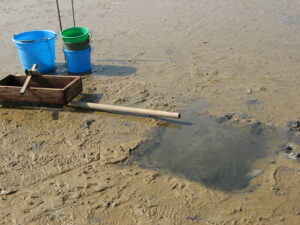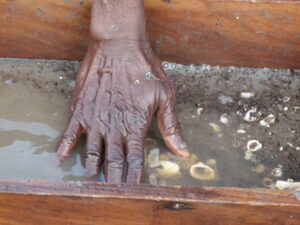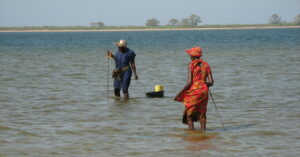18.10.2023
Heavy metals and traditional shellfish harvesting affect mangrove habitats in Senegal
A recently published study led by a doctoral researcher at Åbo Akademi University shows the impact of humans on mangroves in Senegal. Pollution but also traditional shellfish harvesting methods have unintended effects on coastal ecosystems, underlining the importance of local management.
An international team of scientists have investigated the Sine Saloum and Petite Côte, two of the main Senegalese mangrove areas, to evaluate the influence of environment and human activities (i.e. shellfish harvesting and heavy metal pollution) on key coastal animals, namely invertebrates. Results have been published in the journal Estuarine, Coastal and Shelf Science and are clear: the closer to human activities, the more impacts on coastal invertebrates there are.

The authors have collected invertebrates living in the sediments of the seabed between 2007 and 2008.
– These small animals are particularly interesting to look at because they are providing us with food, and due to their restricted mobility, they are vulnerable to changes occurring in their environment, says Maïté P. Jacquot, lead author of the study and doctoral researcher at Åbo Akademi University.
The study showed that in places where shellfish harvesting happened, invertebrates were less abundant and weighed less. Heavy metal pollution affected the diversity of invertebrates, meaning there was less species present on the polluted sites. In places located further away from human settlements, and therefore less affected by harvesting and pollution, invertebrate diversity and abundance were affected by the environment, i.e., water temperature and salinity.
With a billion people living within 20 meters of the coast, disproportionate pressure is placed on coastal ecosystems.
– In order to preserve services provided by coastal habitats (such as food resources), attention needs to be paid to human activities on the coasts. These findings provide important insights for future research, as well as reference points for the implementation of local management measures,” says Jacquot.

This study was part of the project “Femmes et Coquillages” (“Women and Shellfish”), aiming to conduct research on traditional knowledge and practices in order to contribute to the sustainability harvesting of shellfish resources from Sine Saloum and the Petite Côte. Other objectives included improving management capacities, women’s working conditions and living environment, as well as reducing mangrove pollution sources. An initiative following this project is underway with “The Paddle project” aiming at reconciling human uses and conservation, and at offering an attractive setting to combine different uses of marine resources within a single area.
– Since this study, conducted 15 years ago, women in the Sine Saloum have adopted management practices and diversified their activities. It would be extremely valuable to run a new study taking into account the relevant current human activities and compare them with the state of the environment described by the participants, says Jacquot.

Click here for more information about “The Paddle project”.
Maïté P. Jacquot is currently completing her PhD degree at Åbo Akademi University in on the impacts of human activities on invertebrates in several areas of the world, including the Åland islands and the mangroves of Senegal.
Original peer-reviewed article:
Jacquot M.P., Nordström M.C., De Wever L., Ngom Ka R., Ka S., Le Garrec V., Raffray J., Sadio O., Diouf M., Grall J., Tito de Morais L., Le Loc’h F. (2023). Human activities and environmental variables drive infaunal community structure and functioning in West African mangroves. Estuarine, Coastal and Shelf Science 293. doi: https://doi.org/10.1016/j.ecss.2023.108481